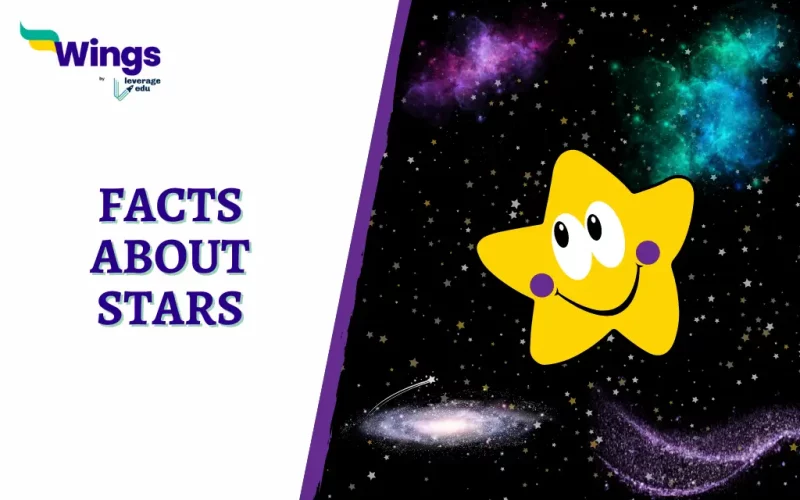On a clear night sky, you look up and you find a couple of stars at first. Then, after a while, a couple more appear! What you might not know is that the universe you are looking up at has more than one septillion stars which is 1 followed by twenty-four more 0’s. These celestial bodies are a wonder to look at and explore as well. Read on to learn more Facts about Stars, that are alive in your night sky.
Facts about Stars
Table of Contents
Furthermore, here are some Facts about Stars!
- Proxima Centauri is 4.25 light years away from us and with our current technology, it would take us tens of thousands of years to get to it!
- The extremely massive stars are the ones that burn fuel faster and have a shorter lifespan as compared to smaller stars such as red dwarfs.
- Stars do not really twinkle as you might have heard in your nursery years. You perceive them as twinkling because of our Earth’s atmospheric turbulence!
- There are many stars that you see which are a part of binary systems which means that two stars orbit each other!
- A star can end its life in a supernova explosion and if it is massive enough, it can turn into a black hole!
- VY Canis Majoris is one of the largest known stars and would engulf the orbit of Saturn if placed at the centre of our solar system!
- Red dwarfs are the most common stars which can live for trillions of years due to their slow fuel consumption.
- Stars are born in clouds of dust and gas called nebulae. Moreover, these young stars are known as protostars.
- A dying star can become a white dwarf which is a dense leftover that no longer undergoes fusion but still emits light until it cools down. For example, our Sun can end as a white dwarf after shedding its outer layers!
- Some massive stars can collapse into neutron stars. They are incredibly dense and observable through infrared telescopes due to their light-bending properties.
- Eta Carinae is one of the most massive stars known to us. It has about 150 times the mass of our Sun and is very luminous!
- All the stars in the universe have nearly the same chemical composition which is hydrogen and helium. Moreover, their nuclear fusion reactions are similar as well!
- Green stars do not exist. You may think that they seem green because of an optical illusion due to our atmosphere.
- The largest star cluster in our Milky Way is the Omega Centauri which has about 10 million stars in itself!
- A star remains stable because of the balance between the gravitational force pulling inward and the fusion pressure pushing outward!
- You would usually associate the colour red with something being hot and blue with coolness. However, that is the exact opposite when it comes to stars. The colour of a star tells us its temperature and mass, with cooler stars appearing red and hotter stars appearing blue!
- Hypergiant stars, like the Pistol Star, emit massive amounts of radiation, thus making their surrounding environments uninhabitable.
- Light from the nearest star beyond the Sun takes over four years to reach Earth!
- Stars maintain stability through continuous fusion of hydrogen into helium, thereby stopping them from collapsing!
- There are Variable stars that go through changes in brightness because of internal or external factors, such as eclipsing binaries!
- Neutron stars are so dense that a sugar-cube-sized amount of their material weighs about a billion tons on our planet Earth!
- Nebulae are known as stellar nurseries as they are regions where new stars are born from collapsing clouds of gas and dust. That is where a star is truly born!
- Globular clusters are spherical collections of stars bound tightly by gravity. Moreover, there are some clusters that have millions of stars within a relatively small region!
FAQs
Stars are so special as they are celestial bodies that produce their light and heat through nuclear fusion. Therefore, making them the building blocks of galaxies and the source of elements that are needed for life.
The lifespan of a star depends on its mass. Smaller stars can live trillions of years on the other hand, massive stars may only exist for a few million years before exploding as supernovae.
Stars are born from immense clouds of gas and dust called nebulae, where gravity causes the material to collapse and ignite nuclear fusion at the core, hence creating a new star.
Stars appear to twinkle because of the Earth’s atmosphere which contorts the starlight as it passes through, hence causing the star’s appearance to flicker and change in brightness.
Relevant Blogs
I hope you had fun reading these 23 Stellar Facts About Stars In Your Night Sky. If you want to know more about topics like this, then visit our Interesting Facts and General Knowledge page!
 One app for all your study abroad needs
One app for all your study abroad needs













